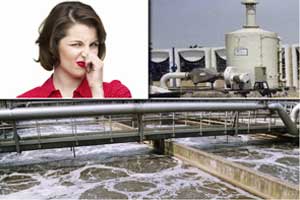
Most of the new sewage treatment plants (STP) are built in Building Basement area. The whole facility is enclosed in a single building. The STP system is a combination of Pre-treatment, primary treatment, secondary (biological) treatment and tertiary treatment.
Sewage Treatment Plants produce odor compounds during the treatment process. These compounds are generated by biological processes at different steps within in the plant. Typical areas of odor emissions are the inlet pump station with bar screen chamber, oil & grease trap, biological process, sludge handling, sludge drainage.
There is a wide spectrum of possible inorganic and organic molecules, which can create unpleasant odors. The most common are ammonia, amines, aldehydes, ketones, sulphur compounds, hydrogen sulphide and mercaptans. Especially for treatment plants located in or nearby residence/commercial buildings these emissions lead to problems with residents. Therefore regulations are in place to reduce the emissions and set limits for selected parameters/compounds.
When the STP are built in the basement of the building, as per the rules of pollution control boards (in India) it is compulsory to provide exhaust from the STP room and it is mandatory to use ozone in the exhaust for odor destruction. Ozone is a very strong oxidizer and reacts quickly with organic compounds, since there are majorly organic compounds releasing from the STP so ozone reacts with the organic compounds instantly and oxidizes them.
Hydrogen sulphide and ammonia are two main parameters restricted by regulations.
The concentration of H2S found in the exhaust air of Sewage Treatment Plant is in the range of 5 - 15 ppm.
The emission level for ammonia is typical in the range of 50 to 150 ppm.
Threshold limit of H2S = 0.002 - 0.15 ppm
Threshold Limit of NH3 = 5 ppm
STP Tertiary Treatment Ozonation Design & Sizing Guide Ozone Air Treatment
Send Enquiry Technical Note Site Photos
Model Data Sheet Process Flow Diagram F A Q Prosoft Questionnaire
Ref : German guideline
Due to existing limits, it is typically required to gather the polluted air via exhaust equipment and to install a treatment system.
Normally for Reduction of Odorous gas requires the dilution with outside air. Due the large capacity of fresh air supply, a duct is required which will dilute the polluted air. Generally 5 – 7 fresh air changes are required for STP Exhaust.
The integration of Air Ozonation System and injection of Ozone into Air Handling System is the latest and most popular technology to reduce H2S and NH3 from enclosed STP Exhaust.
Role of Ozone:
Ozone is a powerful oxidant which rapidly oxidizes odorous gases such as Hydrogen sulphide and ammonia.
Ozone Reactivity with Hydrogen Sulphide and Ammonia:
H2S + O3 → SO2 + H2O
2 NH3 + 4 O3 → NH4NO3 + 4 O2 + H2O
Advantages:
Ozone is the strongest oxidant available for the treatment of odors.
Ozone kills airborne pathogen & viruses.
Although ozone is the strongest oxidizing agent commercially available, it is safe to handle.
Ozone generators are manufactured in Mild Steel & are easy to install.
Ozone is easily generated onsite with oxygen & electricity (both are readily available).
Easy to control ozone concentration by sensors.
Compact in design combined with high efficiency.
Adjustable ozone sensor (0.02 - 0.1 ppm) (Optional)
Oxygen for feed gas with oxygen generator gives constant ozone outputs without any Nitrogen compounds like (nitric acid & nitrous oxides by products).
Saving Intake of Fresh Air from outside for dilution is greatly reduced up to about 80%. Due to air Ozone treatment energy is saved in cooling outside Air and Dramatic saving in cost.
Salient Features:
Ozone generator system is suitable for achieving reduction in volatile organic compounds, organic odors in indoor environment. Ozone Generator system is does not produces any hazardous by‐products.
Ozone Generator system does not produces NOx (Oxides of Nitrogen) so it will not generate nitric acid, which can damage the AHU Ducts.
Feed gas to ozone generator is medical grade dry pure oxygen. Oxygen fed gas purity is 90‐92%.
MOC of Ozone Cell is Stainless/Aluminum with high dissipation design.
Dielectric Tubes is fabricated of Quartz/ceramic 300 to provide high efficiency dielectric.
Electrode is air cooled.
The Ozone Generator is suitable for operation on 230V‐ 50Hz Single phase input power.
Inverter is IGBT based resonant converter.
Deliverables of Ozonation System :
Ozone generator is place in STP Plant room & connected to Exhaust duct line through ozone injector.
Ozone will be injected at entry point of exhaust air duct.
Ozone will be dosed between 1.0 – 2.0 ppm @ 20 – 25 ACH
The ozone generator is floor/skid mounted with integrally piped & wired.
The ozone generator system is designed for continuous operation with auto ON/OFF mode.
Cooling System is provided for cooling of ozone cell.
There are many areas where it is difficult or impossible to reach & physically remove the mildew, fungi or mold. Any organic surface like wood, paper, clothe, paint, in the presence of moisture, sunlight & fresh air is a ideal combination of growth of mold, fungi & mildew. Generally in hotel rooms there are many of those available for example bed undersides, all wooden furniture undersides, under carpet, under ceiling, air conditioning ducts.
Send Enquiry
Questionnaires:
To design & estimate the STP tertiary treatment ozonation few input data are required, and on the basis of the same ozone dose, capacity, integration point, dossing technique is optimized. One who needs the STP tertiary stage ozonation can submit available data and for new plant estimated data & mail us at : solution@chemtronicsindia.com & we will design optimum solution with nominal charges or free of cost. The amount we charge is used for research & development, social cause & donations.
Questionnaire
1. Type of industry (Residential, office, mall, hospital, hotel, etc.)
2. Capacity of the STP
3. CFM of working air blower
4. Exhaust CFM
5. CFM of fresh air
6. Area of the site (STP Plant room area)
7. Air changes per hour
8. Length of the exhaust duct
9. Constituent of exhaust gases.
10. Magnitude of odor.
11. Expected output quality
12. Methodology to check/verify….
13. Location of the site
14. Contact no.













